Spicing Up Power Chord Progressions
Imagine that you’re writing a song. You have the parts of the song figured out and the chord progressions in place. Even the melodies are already done. Yet, something’s missing. The song seems somewhat generic and maybe a little static too. It needs something, but you can’t quite pinpoint what it is. What you could do, is spice up your chords and chord progressions with a few different moves.
See, simple power chords might get boring from time to time. They provide a stable, solid foundation to a chord progression, but they’re not that interesting. What if you spiced them up a bit?
My Method for Making Power Chord Progressions More Fascinating:
I have a habit of writing either with an acoustic guitar, using simple four chords (such as Em, G, C, D etc. you know, the usual bonfire chords.) or with an electric guitar using power chords. I figure out the basic chord progressions that I want to use underneath my melodies. Then I record the melodies and chord progressions down really simply at first, so that I have the basic structure set up.
When recording chord progressions, I want to use power chords at first, because I’ve found that fuller chords limit my song writing. They simply restrict too much. Keeping things simple at this point helps build the song more unique and interesting later on.
After recording the melodies and chord progressions, I start to play around with the chords. Essentially I don’t want them to be simple power chords strumming eight notes all the way through the song. What I want is to make my song recognizable and awesome, starting from the chords I use. I bet you do too. There are at least four different ways to spice up chords and chord progressions.
4 Ways of Spicing Up Power Chords
Let’s go ahead and take an example of a chord progression that we then spice up little by little. We’re working on a chorus here. The key of E-minor is quite common so let’s form a chord progression using that. Also probably the most common chord progression is Em, C, G, D, (the first, sixth, third and seventh chord of E-minor key.), so might as well use that. You can follow the pictures below to see how I’m changing the chords and listen to the audio files underneath them to hear the changes. So let’s begin, this is what we start with (the chord progression is played twice):
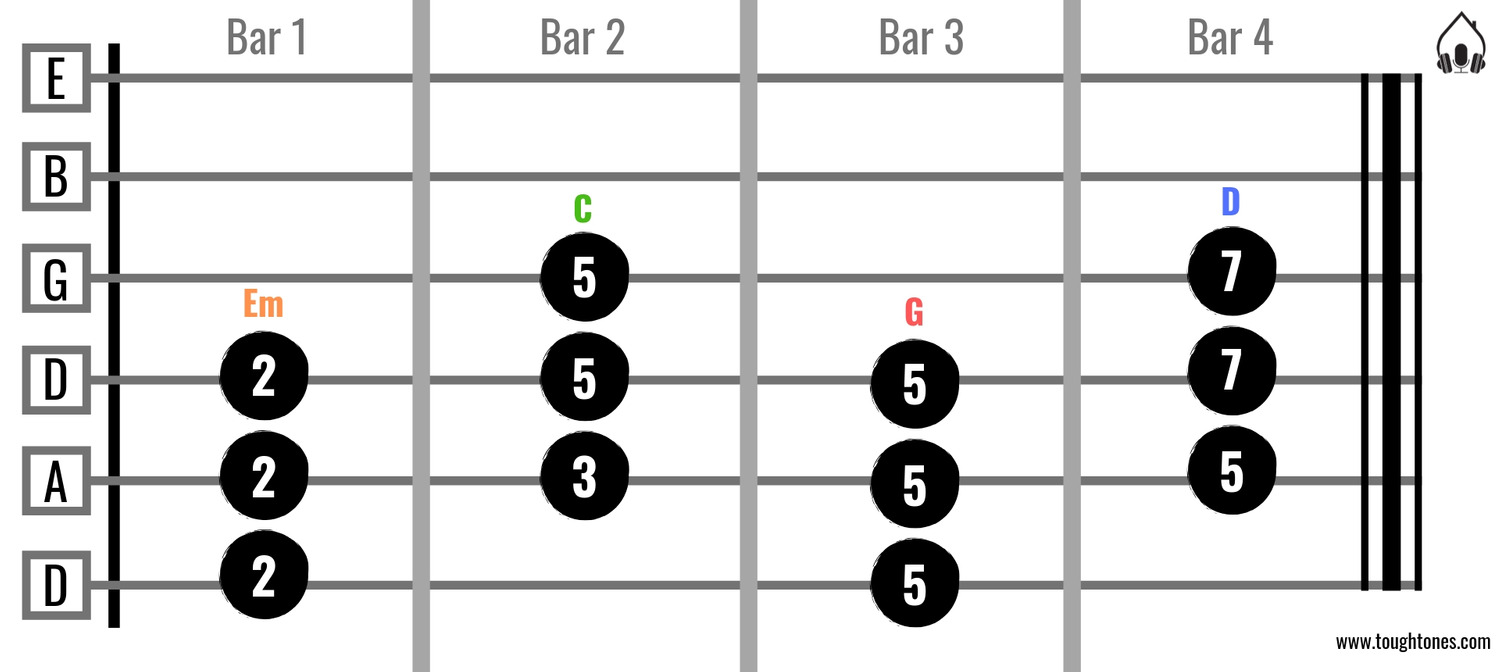
Adding Notes to Chords
Adding notes to power chords is a great way to add something more. I’m not talking about simply making the chords bigger in terms of, for example, adding a third note to every single power chord. No, I’m talking about strategic notes here and there to breathe some life into the chord progression.
Back to our example:
As you can see from the pictures below, there are two “new notes” on Em: the third note (g) and octave of fifth note (b).
On top of power chord C, there’s also b-note. In G there’s also the note b, creating a pleasant tension throughout the first three chords unraveling neatly to the final chord.
Underneath the D-chord there’s f#-note, making the chord D/F#, since f# is the lowest note on that chord. It means that the bass note is f#, but the chord is still D.
On the second round of the chord progression, the only change is in G. Instead of the note b, there’s an octave of d.
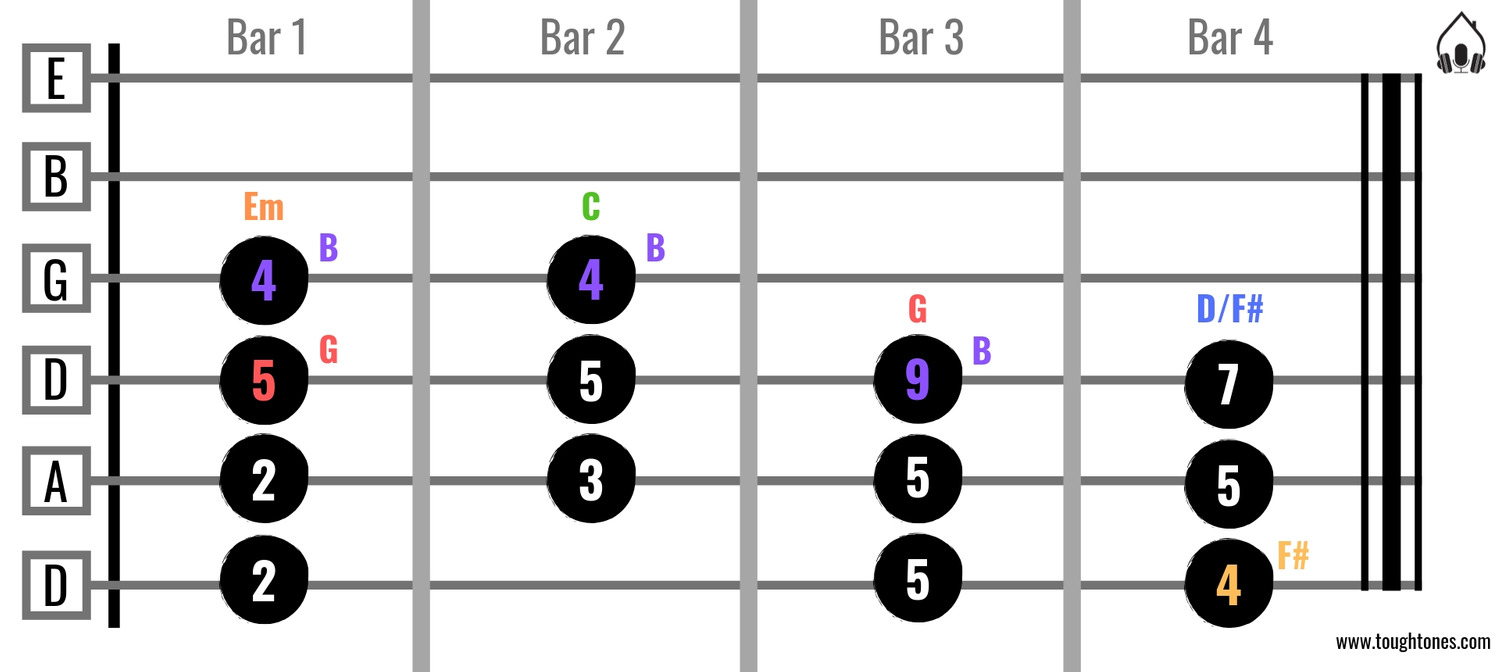
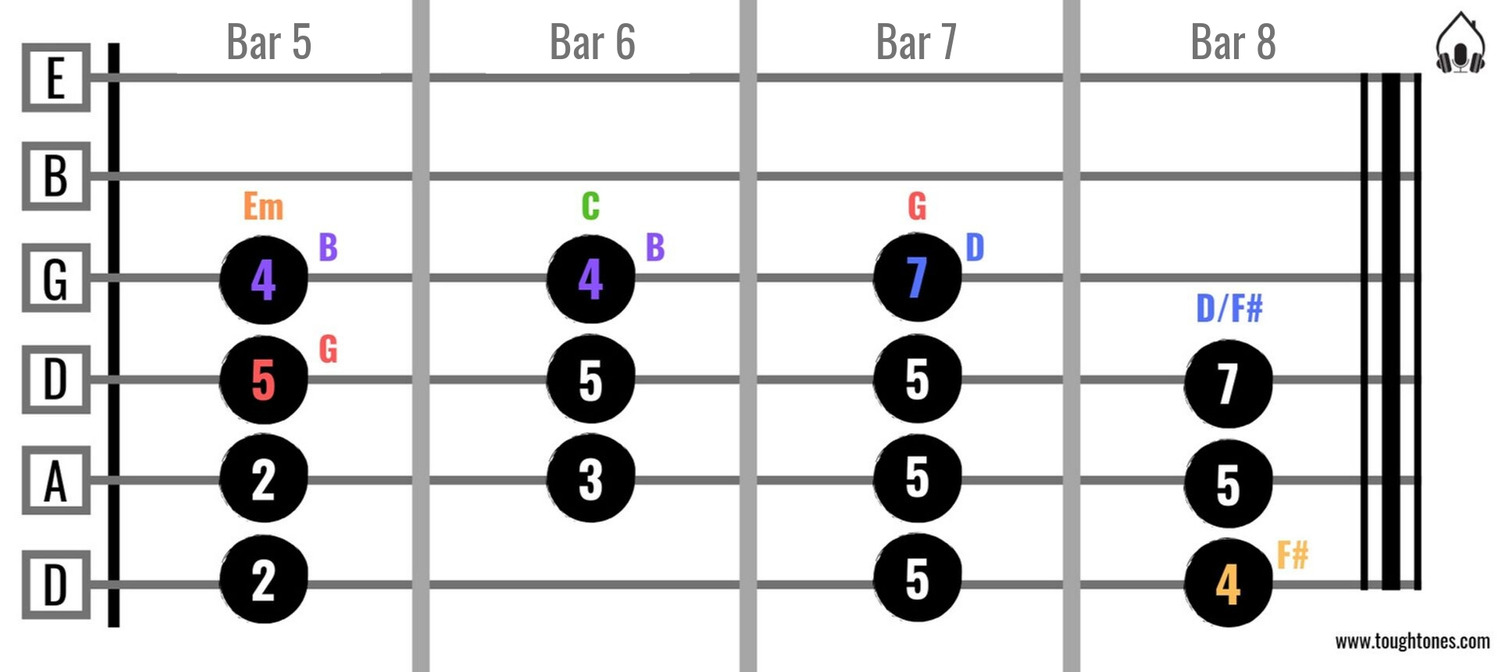
The changes already made our chorus more unique and engaging. All we did was add a few notes. Moving on.
Variating Rhythm of the Chord Progression
Next up, we could focus on the rhythm and make it slightly more interesting. The old 8th or 16th note strumming gets boring quite fast, although there’s a time and place for that too. We want our chorus to stand multiple listenings and to be something more than just another rock chorus, right?
We don’t have to change the entire rhythm though, all we want is some variation. So what we could do, is change half of it – maybe the first two bars of the chord progression. The rest stays intact. Let’s try that:
That made a huge impact. Now there’s some cool variation going on. Our little chorus starts to sound like a real song already. Awesome, what next?
Palm Mute
You’re probably already familiar with palm muting, but here’s a little recap anyway: Palm muting is the thing where you damp the strings with the side of your picking hand, almost muting the strings. It’s used a lot in rock and metal music. Palm muting makes notes more short and defined. If you’ve ever listened to the likes of Metallica or Iron maiden, you know what I’m talking about.
Why don’t we use palm muting in strategic places to make our chorus even more lively? We don’t want it all over the place, so let’s use it in the fourth and eighth bar of our chorus. That ought to add some nice details into the chorus. Listen to what that sounds like:
Sounds great. As we used palm muting in only two bars, it didn’t do anything earth shattering. All in all, it’s a nice spice anyway and there’s much that can be done with it. It’s totally worth experimenting with. Let’s continue.
Short Riffs
The final move that we’re going to make, is to add short riffs or licks. Sounds complicated, but these could be as simple as one or two note movements inside of a chord. It might be a good idea to keep riffs and licks short and on point, supporting the vocals, without getting in the way of the melody too much. This way there’s still space for vocals, even though the chorus might be busy otherwise. If you already know, for example, that you’re going to take a break with vocals at some point, that’s a great place for a more melodic or complex riff.
We don’t have a vocal melody in our chorus, but let’s say our vocalist sings the first three bars and then takes a break in the fourth bar. That’s our spot – the fourth bar – to be a little more experimental with riffs. On the first three bars we could keep it pretty simple, but still offer the listener some treats. Let’s try that:
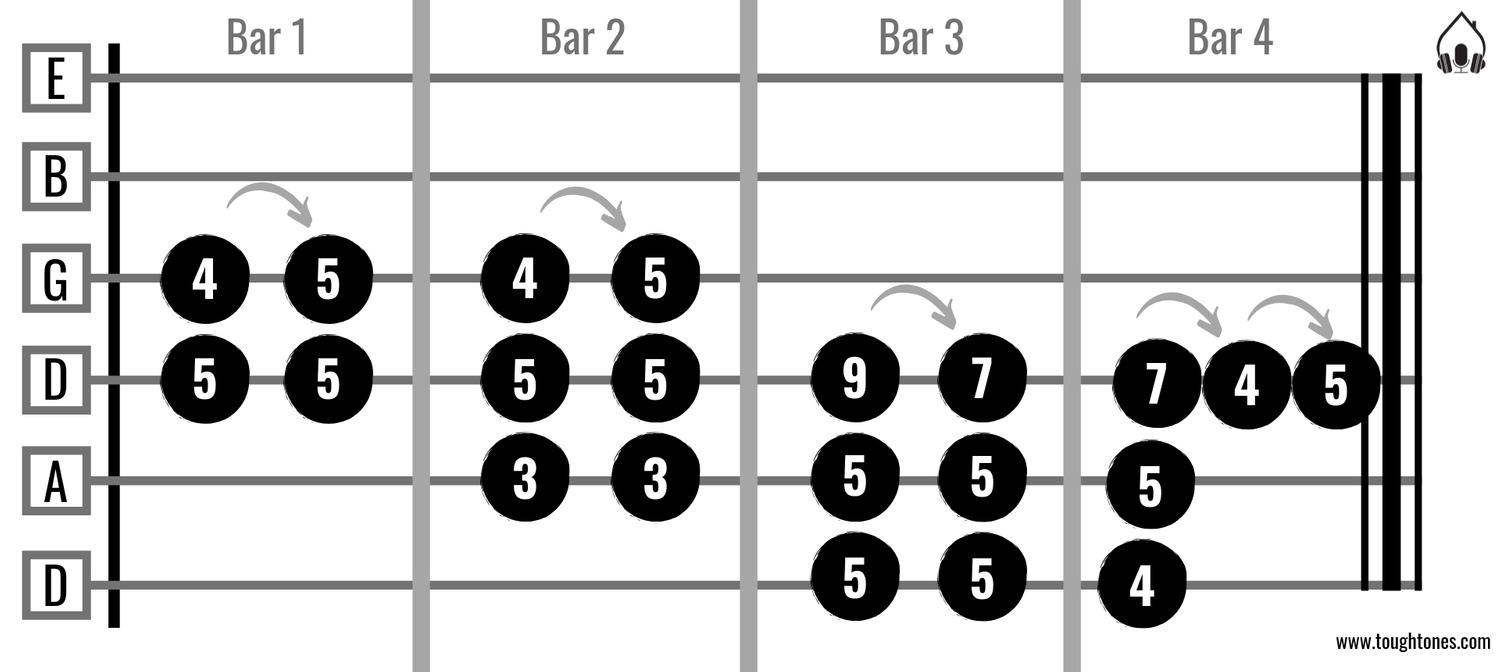
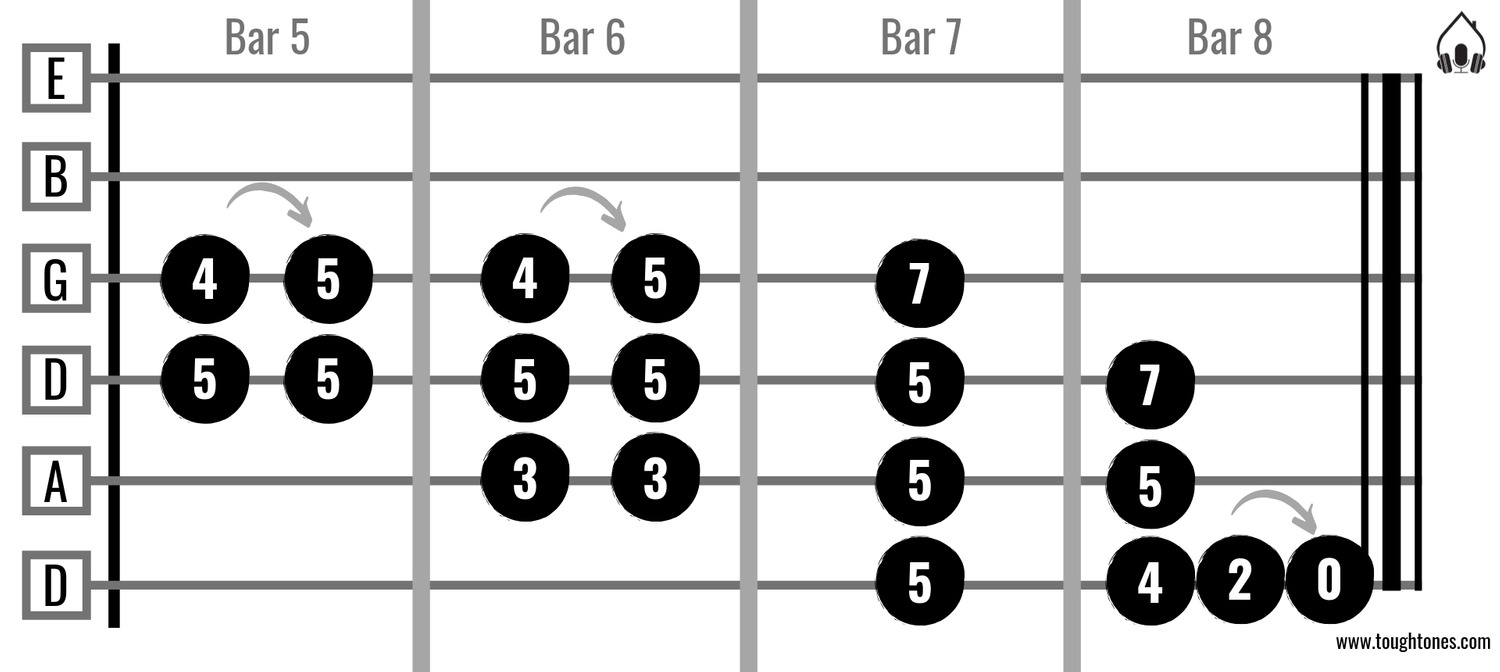
There you go, our chorus starts to sound like a real piece of music. We’ve come a long way from simple power chord strumming. Here’s a comparison of how our chorus sounds before and after the changes:
Before:
After:
Summary
To conclude really briefly, the four ways of spicing up power chord progressions are adding notes, variating rhythm, palm muting and short riffs.
Although we added every single one of these in our chorus, it might not always be the best idea. It can easily turn a chord progression a bit hasty and nervous. You could consider leaving out some of the moves, depending on how well the vocals sit in.
However, that’s why you might not want to use all four of them at the same time. Maybe start with one or two and see how it sounds. As always – do what works for you and serves your music the best.
Hopefully this post gave you some insight on how to spice up your chord progressions. Leave a comment or send me an email of your thoughts. Thanks for reading. Check also these useful guides to help you further with songwriting:
5 Steps to Create Music Faster (..and avoid the writer’s block!)
6 Step Guide to Realistic Midi Drums
You can get them for free today, no strings attached, enjoy!
